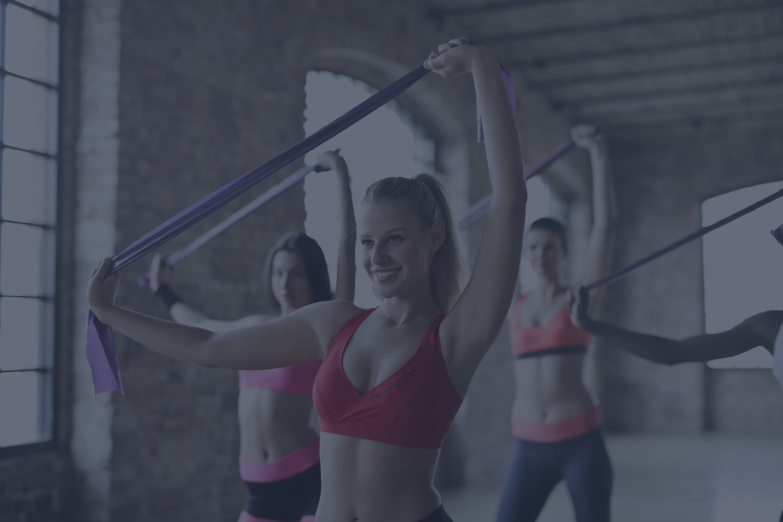
Resistance bands have been used by athletes for years to improve their game performance - increasing their speed, power, and agility while protecting them from the dreaded injury.
But resistance bands aren't just for athletes. Whether you've never exercised a day in your life or complete yearly Ironman marathons, you can reap the benefit of these inexpensive, multipurpose workout tools. They can help you build muscle, lose weight, and give you the freedom to do workouts from virtually anywhere.
There are a variety of resistance and work out bands available like the resisted bungee band, resistance loops, booty bands, tennis resistance bands, leg resistance bands, and pull up assist bands. The price point makes them easy to access, even for those that don't have a ton of extra cash to drop on their fitness goals.
We are here to show you how to use resistance bands to get to your fitness goals faster! Let’s take a look at all the ways adding resistance bands can up the quality and intensity of your workouts!
Benefit #1 - Engage your Stabilizer Muscles and Extra Muscle Tension
Stabilizer muscles help steady our joints while we perform an exercise. They don't support the active joint in the exercise but instead stabilize the other joints in our body in order to be able to perform the movement properly.
Traditional weight lifting focuses solely on the active working muscles in an exercise.
One of the benefits of resistance bands is that they provide constant tension throughout the exercise. Your core and stabilizer muscles get recruited to help keep proper form. Using bands focuses on both active and stabilizing muscles so you get more bang for your buck, and awesome core strength to boot.
In traditional weightlifting, the muscles are only activated during the concentric portion of the exercise. Using a resistance band, your muscles get worked both during the concentric (muscle shortening) motion and eccentric (muscle lengthening) motion. This provides extra tension on the muscle during the exercise and moving through the full range of motion, which leads to stronger, more toned muscles.
Benefit #2 - Increased Speed, Power, and Agility
One of the main benefits of working out with bands is that they’ll improve your athletic performance - they will help you run faster, jump higher, and move quicker.
You can use a resisted bungee band to work on acceleration from a starting position doing resisted sprints, or top-end speed with over-speed training.
You can use resistance bands for speed and quickness training with resisted lateral shuffles or to improve explosiveness with exercises like resisted broad jumps or resisted lateral jumps.

Benefit #3 - Great for Compound Movements
Using resistance bands for working out is a great way to get a lot of work done in a fraction of the time it takes to do traditional weightlifting routines.
Compound movements use several muscles at the same time. Resistance bands can be used on several parts of your body. With exercises like a squat to overhead press, or perform bicep curls and lunges with bands, You can use the band to work both your leg/gluteal muscles and arms/shoulders simultaneously.
Benefit #4 - Modification of Exercises
One of the benefits of resistance band training is that you can modify exercises easily. Whether you can't perform a full pull up on your own yet, or have an injury that keeps you from using traditional weights, resistance training with bands will help you to get to the next level.
Benefit #5 - Reduce Chance of Injury
What do resistance bands do to help avoid injury? They're much easier on your joints than conventional weightlifting. and are often used by athletes recovering from injuries or athletes who are in-season.
While they remove pressure on the joints compared to traditional weights, they allow for more focus on stimulating the muscle instead.
Overhead athletes such as baseball, softball, and volleyball players, as well as football quarterbacks, can also use throwing mobility bands to help prevent injuries and strengthen their shoulders.
“Clangin' and bangin'”, as The Rock would say, is still incredibly important for building strength but resistance band training has claimed its place in the gym as well.
Benefit #6 - Weight Loss
One of the biggest resistance band benefits is the potential for weight loss. The keys to weight loss are healthy eating, building muscle, and burning calories. When exercising with the goal to lose weight, compound resistance band exercises will be your best friend.
With the range of compound exercises available using resistance bands, the total calories burned in a workout can skyrocket which reaps some instant benefits.
You also can change your body composition with bands to help lose weight and keep it off long term. You build muscle exercising with resistance bands, and even when your body is at rest your muscles burn more calories each day (1 lb muscle burns 5 calories) compared to fat (1 lb fat burns 2 calories).
Benefit # 7 - Lightweight
One of the big resistance band training benefits is that they are super lightweight. They are incredibly handy to take with you and work toward your fitness goals while you travel.
They're also easy to keep at home as they require virtually no storage space.
Benefit #8 - Inexpensive
Buying a set of traditional dumbbells can add up quickly. You usually need to get several sizes for different body parts and to increase your weights as you improve. This adds up to hundreds of dollars worth of equipment.
One of the benefits of resistance bands is that they are an inexpensive investment with big rewards. Most bands start around the $20 mark and you can use one resistance band to exercise your entire body.
Resistance bands work based on pressure - the more pressure you apply to the band, the more the band pushes back. This means you can build your strength by using the same band and increasing pressure as you get stronger at the movement.
If you do get to a point where you feel that your band isn't providing enough tension, you can move up to a thicker band, which provides more tension and makes each exercise more difficult.
Benefit #9 - Getting More Out of Bodyweight Exercises
Resistance bands like bungees or leg resistance bands are great for progressing bodyweight exercises.
For example, you can use leg resistance bands to easily add resistance to:
- Lunges
- Step-Ups
- High Knees

While a resistance bungee band works well to add resistance to:
- Sprints
- Lateral Shuffles
- Lateral Jumps
- Broad Jumps
Combined, these bands help you to get more out of bodyweight exercises. They are especially beneficial when utilizing contrast training by doing a few sets of resisted band work followed by a few sets without the band.
How to Choose a Resistance Band
The resistance band you choose depends on a couple of things.
What exercise are you doing? Some exercises, like squats, are best with a basic loop style band. Many exercises have specific bands designed for them like the assisted pull up band or a bungee band for sprints. It's best to invest in a few different bands upfront that you can use to work on your own specific fitness goals.
How much resistance do you need? You want your band to provide enough resistance to challenge your body and build your strength. To determine which band is best for you, try to do 12-15 reps of the exercise. If you don't feel tired, you need to up the resistance. You want to be challenged by the exercise but still able to maintain good form throughout the movement.
How to Design a Resistance Band Routine
Here's how you can create an effective full-body resistance band exercise routine:
- Choose your bands. As we outlined above, you will want to base your exercises around the bands you have available to you. Ensure you have a band that provides enough resistance to be a challenge for your body.
- Choose your exercises. Pick 8-12 exercises that work a variety of muscle groups for the best results. Ensure you learn how to perform each exercise with proper form.
- Perform 12-15 sets of each exercise.
- Repeat the circuit 3 times.
- Perform the routine 2-3 times/week. Be sure to choose alternating days and avoid back-to-back days to allow ample time for muscle recovery and not slow your results.
- Increase resistance as you improve. If the exercises get too easy it's time to move up to a more challenging band.
Takeaway- Working out with bands
Now that you have seen the benefits of adding resistance bands to your workouts, you will be wishing you had known about these underrated pieces of equipment much sooner! Grab some and see just how much faster you can reach your goals!
If you really want to take a plunge into the world of resistance bands, you can even craft a warmup using bands. To find out more check out Resistance Band Stretches.









Leave a comment (all fields required)